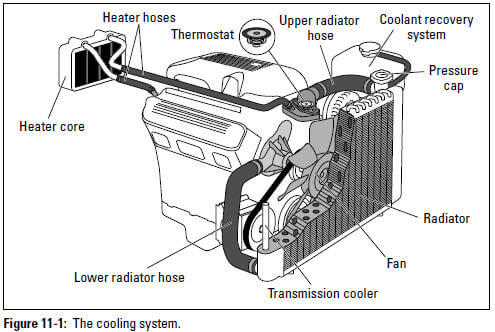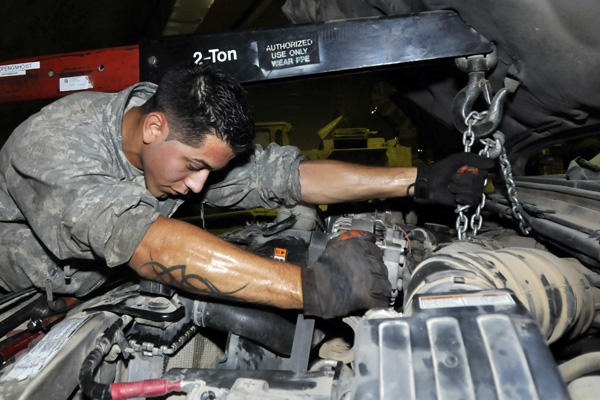The Radiator
When the fuel/air mixture is ignited in the cylinders, the temperature inside the engine can reach thousands of degrees Fahrenheit. It takes only half that heat to melt iron, and your engine would be a useless lump of metal in about 20 minutes if your vehicle couldn't keep things cool. Naturally, the coolant (and water) that circulates from the radiator through the top radiator hose to the thermostat and around the cylinders in the engine block gets very hot, so it's continually circulated back to the radiator via the bottom radiator hose, where it cools off before heading back to the scene of the action. The radiator's pressure cap keeps your car from boiling over, and the coolant recovery system holds extra coolant so it doesn't overflow onto the roadway.
The Hoses
The radiator is designed to cool the liquid quickly by passing it over a large cooling surface. The liquid enters the radiator through the top radiator hose, which is usually connected to (you guessed it) the top of the radiator (refer to Figure 11-1). As the liquid descends, it runs through channels in the radiator that are cooled by air rushing in through cooling fins between the channels. When the liquid has cooled, it leaves the radiator through the bottom radiator hose (surprise!). This hose usually has a spring inside it to prevent it from collapsing when the water pump draws coolant from the radiator.
 |
Smaller-diameter hoses also lead from your engine to the heater core. Some vehicles have a small bypass hose near the thermostat as well. These hoses are an important part of the cooling system because they're designed to carry the liquid in it from one component to another.
The Coolant Recovery System
A coolant recovery system is a plastic or metal container with two little hoses coming out of the cap (see Figure 11-2). One hose leads to the radiator, and the other serves as an overflow pipe for the container, which holds an extra supply of water and coolant in case the system loses any.

Car Smarts: When your cooling system heats up and starts to overflow, the liquid pours back into the recovery system reservoir instead of pouring out of the radiator overflow pipe and onto the ground. When the system cools off, the pressure drops and the liquid is drawn out of the reservoir and back into the radiator. This process not only saves you coolant but also protects animals and children from sampling puddles of the toxic stuff.
Some of today's new vehicles have pressurized reservoirs. In these cases, you may find the pressure cap on the reservoir and not on the radiator. I've been told by radiator specialists that, on some vehicles, this system doesn't work very efficiently because, as the pressure builds up in the coolant reservoir, it forces the coolant out of the overflow pipe and onto the street. Not only is this overflow a toxic hazard, but as the coolant supply diminishes, the chance of the engine overheating increases, leading to a vicious circle.
Many recovery systems are considered "sealed" because you add water and coolant by opening the cap on the reservoir rather than on the radiator. You also check the level of liquid in the system by seeing whether it reaches the "Max" level shown on the side of the container rather than by opening the radiator and looking inside.
The Pressure Cap
To further retard the boiling point of the liquid in the cooling system, the entire system is placed under pressure. This pressure generally runs between 7 and 16 pounds per square inch (psi). As the pressure increases, the boiling point rises as well. This combination of pressure plus coolant gives the liquid in your cooling system the capability to resist boiling at temperatures that can rise as high as 250°F or more in some vehicles.
To keep the lid on the pressure in the system and to provide a convenient place to add water and coolant, each radiator has a removable radiator pressure cap located on either its radiator fill hole or its coolant recovery system.
Car Smarts: The pressure cap has two valves: a pressure valve that maintains a precise amount of pressure on the liquid in the system, and a vacuum valve that allows the liquid to travel back into the radiator from the recovery reservoir.
Caution: Pressure caps are relatively inexpensive, but if you have a cap that isn't working properly, or if you have the wrong type of cap, you'll be amazed at the amount of trouble it can cause. For example, if the gasket inside the cap isn't working, the pressure in the system will escape, allowing the liquid to boil at a lower temperature. A modern cooling system that has been designed to operate normally at temperatures over 212°F, and that is filled with liquid and in perfect condition, will still continually boil over if the radiator cap isn't operating efficiently. That boiling liquid will be forced into the overflow system, and your vehicle's engine will overheat. An overheated engine can cause an inconvenient highway breakdown and possible danger to your engine.
From Auto Repair for Dummies, copyright © 2009 by Wiley Publishing, Inc., Indianapolis, Indiana. Used by arrangement with John Wiley & Sons, Inc.










